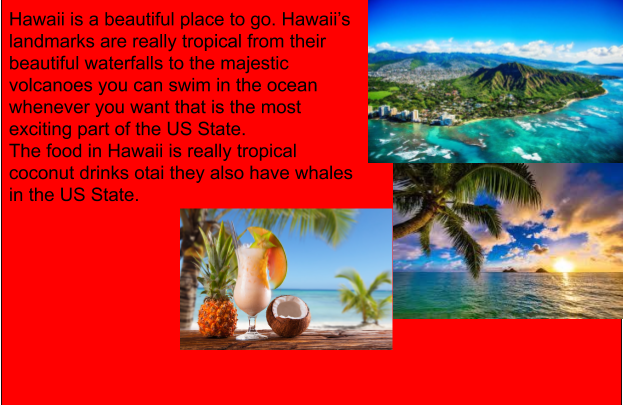These are my designs that I made for the school Art Tour. These designs mostly symbolises the signs of respect but some of them symbolises the joy of where the art comes from.
Friday 4 December 2020
2020 Artwork
These are my designs that I made for the school Art Tour. These designs mostly symbolises the signs of respect but some of them symbolises the joy of where the art comes from.
Thursday 3 December 2020
Term 4 Art Alive Patterns
This term we have been learning about art from around NZ and the Pacific. Take a look at some of my patterns.
Monday 30 November 2020
Wednesday 25 November 2020
Tuesday 24 November 2020
Questions - Hawaiian Art Forms
Hawaiian Art Form:
First read the text & then Highlight the correct answers
1. What year did American Christian missionaries first arrive to Hawaii?
a) 2020 b) 1820
c) 1893 d) 1960i
2. Why did Hawaiian art like kapa-making disappear?
a) because the arrival of American Christian missionaries b) because of Queen Lili’uokalani was no longer ruler of Hawai’i
c) because they ran out of trees to create kapa
d) because Hawaii was governed by westerners
3. ‘In the 1960’s native Hawaiian began to revive the art of making kapa? What does ‘revive’ mean?
a) type of coffee b) restore
c) breathe life into d) a dance
4. The Hawaiian name for Petroglyphs?
kapa b) alii
c) kii pohaku d) Lilo
5. What is petroglphs?
a) an Egyptian picture b) the King of Hawaii
c) a village d) lava rock carvings
6. True or False: Petroglyphs possibly recorded births and events in the lives of people?
a) True b) False
7. A popular site that features Petroglyphs in Hawaii?
Kailua-Kona b) Kahua
holua d) Kaloko-Honokohau
8.Feather work was only for royalty and important people?
a) true b)false
9.Wearing a hulu manu could make you feel mana, or spiritual power ?
a) True b) False
10. How do they collect the feathers?
→From birds caught specifically.
Monday 16 November 2020
Questions - Hawaiian History & Art History
Hawaiian History:
Highlight the correct answers
About Hawaii:
1. Hawaii has eight main islands - which one is not part of Hawaii?
a) Niʻihau b) Kauaʻi
c) Oʻahu d) Savai’i
2. What is the capital of Hawaii?
a) Wellington b) Maui
c) Honolulu d) Moloka’i
3. Native Hawaii before and after European contact produces?
a) petroglyphs b) wood and stone carvings
c) siapo d) kapa
4. The designed feather cape or helmet is solely for?
a) teachers b) alii
c) kings d) chiefs
5. Kia manu would collect incredible --------------------?
a) 20,000 birds b) feathers
c) hair d) chicken feet
6. True or False: Kapa is made from colourful dyes ?
a) True b) False
7. By using wauke or paper mulberry plant they ---------- to form a Kapa?
clean b) buy
beat d) hammer
8. Sculpting in Hawaii they use ------------?
a) bone b) stone
c) wood d) teeth
9. A hand-tapping needle piercing the skin is used for traditional Hawaiian Tattoo?
a) True b) False
10. What is one of the processes of Kapa?
→Kapa is a process that is tattooed from the bone.
Wednesday 11 November 2020
Questions - Cook Islands Staff God
Cook Islands - staff god
Highlight the correct answers
Atua Rakau:
What is a staff god?
Name for our kitchen b) a stick in form of a god
c) Movie on netflix d) a religion
2. What material is the staff god made from?
a) ice b) wood
c) diamonds d) iron
3. What does elaborately mean?
a) intricate b) tiny
c) disgusting d) detailed
4. How did the European missionaries view staff gods?
a) secular b) American idol
c) idols d) demonic
5. How long is the surviving staff god ?
6 metres b) 2 metres
c) one third of the length d) 19 metres
7. Which best describes this staff god?
Smooth green eyes with stylised head, mouth, ears; a curved back with notches on the ear side
Smooth eyes with stylised ears; a curved ankle with notches on the shoulder sides
Smooth head with stylised ankles, mouth, noese; a curved neck with notches on the back sides
Smooth head with stylised eyes, mouth, ears; a curved neck with notches on the back sides
8. How did William Ellis described the staff gods?
=>Imbecility, Absurdity and degradation of idolatry.
9. When was Christianity introduced to Cook Islands?
2020 b) 19th Century
c) 2019 d) 1900
Tuesday 10 November 2020
Questions - Cook Islands Art Forms
Cook Islands Tivaevae:
Highlight the correct answers
Tivaevae:
What does Tivaevae mean?
To cook b) to sew or patch
c) To knit d) to laugh
2. What are Tivaevae?
a) Tea Towels b) Pillow Cases
c) Sheets d) Duvets
3. When were Tivaevae bedspreads introduced by French nuns?
a) eighteenth century b) nineteenth century
c) twentieth century d) twenty first century
The Pange
4. What is a pange?
=>A pange in cook islands is a group that makes Tivaevae.
5. What is a ta’unga?
a) a type of tivaevae b) an expert
c) cutting materials d) patterns and colours
Making the Tīvaevae
6. Which are not part of the three types of Tīvaevae?
a) tīvaevae manu b) tīvaevae tātaura
c) tīvaevae tā’ōrei d) tivaevae tāmoumou
7. Which best describes what Tivaevae manu?
It uses only four colours and two pieces of material.
It uses only one colour and one piece of material.
It uses only two colours and two pieces of material.
It uses only two colours and three pieces of material.
8. How is Tīvaevae tātaura formed?
Using glue and paste b) using embroidered
c) having separate pieces pieced together d) using chromebook








